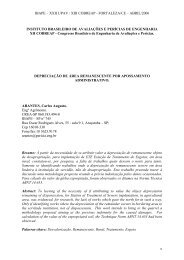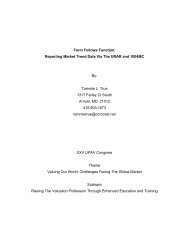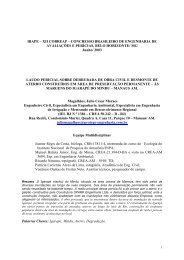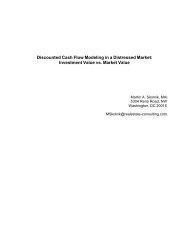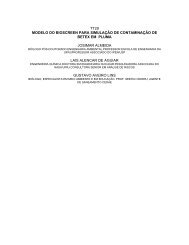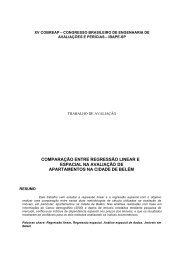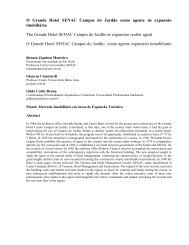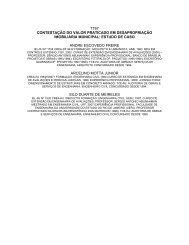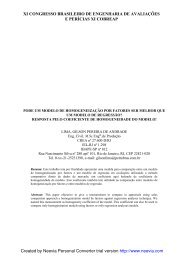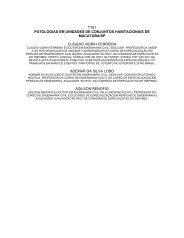Integration of a Green Metric into Appraisal Methodology
Integration of a Green Metric into Appraisal Methodology - Mrcl.com.br
Integration of a Green Metric into Appraisal Methodology - Mrcl.com.br
- No tags were found...
You also want an ePaper? Increase the reach of your titles
YUMPU automatically turns print PDFs into web optimized ePapers that Google loves.
<strong>Integration</strong> <strong>of</strong> a <strong>Green</strong> <strong>Metric</strong> <strong>into</strong><br />
<strong>Appraisal</strong> <strong>Methodology</strong><br />
Subtopic: Setting International Valuation Standards<br />
Tracy Reiss, Real Estate Appraiser, MPA and LEED AP<br />
The William Fall Group<br />
129 Bennington Road, Akron, Ohio 44313<br />
Telephone: 330.289.0041<br />
Email: treiss@williamfallgroup.com
Page2<br />
Table <strong>of</strong> Contents<br />
1. Introduction. ................................................................................................................ 3<br />
2. Sustainability, <strong>Metric</strong>s, and Assumptions. ................................................................... 3<br />
2.1 Sustainability. ......................................................................................................... 3<br />
2.2 Impacts <strong>of</strong> Sustainable Attributes on Value ............................................................ 4<br />
2.3 <strong>Metric</strong>s ................................................................................................................... 5<br />
2.4 Assumptions .......................................................................................................... 6<br />
3. Economics, Real Estate and Market Value. ................................................................ 6<br />
3.1 Economics (and the Role <strong>of</strong> Information) ............................................................... 6<br />
3.2. Real Estate (and Emerging Market Transformations). .......................................... 8<br />
3.3. Value Creation (and Bundles <strong>of</strong> Rights) ................................................................ 9<br />
3.4. Summary ............................................................................................................. 10<br />
4. Suggested <strong>Green</strong> <strong>Metric</strong> Components ...................................................................... 10<br />
4.1 Emphasis upon a performance-based approach ................................................. 11<br />
4.2 Focus upon the net present value <strong>of</strong> the stream <strong>of</strong> benefits ................................. 11<br />
4.3 Additional data requirements ............................................................................... 12<br />
4.4. Summary ............................................................................................................. 13<br />
5. Hypothetical <strong>Green</strong> <strong>Metric</strong> Application Case Studies ................................................ 13<br />
5.1. Upon Highly-Performing Properties..................................................................... 13<br />
5.2. Upon Damaged Properties .................................................................................. 15<br />
5.3. Within an Economy Wherein Carbon is Priced ................................................... 16<br />
5.4. Summary ............................................................................................................. 18<br />
6. Conclusion ................................................................................................................ 18
Page3<br />
1. Introduction.<br />
Changing economic and environmental trends are reshaping the global financial<br />
system. This manuscript highlights trends related to sustainability and examines the<br />
central role <strong>of</strong> commercial real estate therein. Justification for a green metric is provided<br />
via a conceptual framework embedded in both economic and appraisal theories.<br />
Recommendations regarding pertinent components <strong>of</strong> a green metric are introduced.<br />
Hypothetical application <strong>of</strong> the metric to highly performing properties, damaged<br />
properties, and future international economies wherein carbon is priced concludes the<br />
manuscript.<br />
2. Sustainability, <strong>Metric</strong>s, and Assumptions.<br />
Section 2 explores sustainability and commercial real estate. Highlights from recent<br />
studies are provided. The standardizing role <strong>of</strong> a metric as a means through which to<br />
encourage more efficient markets is explored.<br />
2.1 Sustainability. Sustainability has many definitions. For our purposes, a simple<br />
definition will suffice. Sustainability is ―improving the quality <strong>of</strong> human life while living<br />
within the carrying capacity <strong>of</strong> supporting ecosystems‖ (Union). Sustainability is holistic<br />
in nature and integrates a long-term approach premised in triple bottom line benefits<br />
that are economic, environmental, and equity-based in nature. Typical sustainability<br />
considerations include, but are not limited to: renewable resources, recycled products,<br />
energy efficiency, and conservation measures. Sustainable building (aka green building)<br />
integrates environmental considerations <strong>into</strong> overall design, construction, and<br />
maintenance. Interest in green properties has grown exponentially in recent years, with<br />
concerns regarding high energy costs providing an additional boost. The simultaneous<br />
emergence <strong>of</strong> global economic constraints within an age <strong>of</strong> growing environmental<br />
awareness, has resulted in circumstances wherein sustainability considerations have<br />
increasing relevance.<br />
Buildings form one <strong>of</strong> the major catalysts for environmental degradation on the planet.<br />
Energy utilized by buildings is a tremendous drain on the earth’s natural resources,
Page4<br />
which in turn has a huge impact on our economy (Simmons, Introduction, webinar).<br />
While overall statistics regarding energy usage and waste generation vary, most all tend<br />
to be staggering in their impact. In 1995, a groundbreaking summary delineating the<br />
impacts <strong>of</strong> buildings on the environment was published by the World Watch Institute. In<br />
it, authors noted that buildings consume 40% <strong>of</strong> world energy production, 17% <strong>of</strong> all<br />
water pumped out <strong>of</strong> natural water flows, and 25% <strong>of</strong> all virgin wood harvested<br />
(Lenssen). According to recent data provided by the Energy Information Administration<br />
(EIA) on a global level, buildings (residential, commercial, and industrial) collectively<br />
represent 72% <strong>of</strong> all end use energy consumption (EIA).<br />
The commercial and industrial sectors alone represent<br />
50% <strong>of</strong> the energy consumed by end use (see 2008 EIA<br />
chart at right). Nearly 50% <strong>of</strong> all greenhouse gas<br />
emissions overall are attributed to the commercial and<br />
industrial sectors <strong>of</strong> the economy, either through the<br />
burning <strong>of</strong> carbon-based fuels for heating and<br />
manufacturing or through the use <strong>of</strong> electricity. (Company 1).<br />
By virtue <strong>of</strong> its proportionately large share <strong>of</strong> energy usage, buildings are likely to be<br />
affected as sustainability considerations continue to be integrated <strong>into</strong> the market. It<br />
follows that improving the energy efficiency <strong>of</strong> commercial buildings alone would have a<br />
tremendous impact an individual’s ability to ensure sustainability and be likely to<br />
positively influence value. The more efficiently a building can operate while consuming<br />
fewer resources, the more sustainable, and therefore valuable, that real estate is likely<br />
to be long-term.<br />
2.2 Impacts <strong>of</strong> Sustainable Attributes on Value. Given increased interest in green<br />
properties, numerous studies have been conducted in attempts to capture value<br />
influences attributable to sustainable design features. The data have revealed ―that the<br />
value <strong>of</strong> a building can be linked to the building’s perceived level <strong>of</strong> sustainability‖ (Reed<br />
1). Many <strong>of</strong> the studies have demonstrated positive influences on value in green<br />
properties directly related to factors such as: lower operating costs; longer life spans;
Page5<br />
rental premiums; higher relative investment returns; higher occupancy rates; and higher<br />
sales prices. Furthermore, as findings from a recent survey conducted by CoreNet<br />
Global and Jones Lang LaSalle demonstrate,<br />
more respondents are considering<br />
sustainability factors (in general) in decisions<br />
related to real estate. Specifically, while a<br />
stable 89% <strong>of</strong> respondents continue to<br />
consider green building certification, the<br />
percentage that ―always consider‖ them rose<br />
from 26% to 41%. A new question in 2009<br />
further revealed that 90% <strong>of</strong> respondents consider energy scores or labels to be<br />
important‖ (LaSalle 3). Volumes <strong>of</strong> similar data are growing as are consumer<br />
expectations in support <strong>of</strong> the inclusion <strong>of</strong> green features. Further and detailed analysis<br />
<strong>of</strong> the documented studies in support <strong>of</strong> sustainable attributes and their positive<br />
influence on value is beyond this scope <strong>of</strong> this paper. However, ―it makes sense that<br />
sustainable buildings should have more value. They are built better, are better stewards<br />
<strong>of</strong> the environment, consume less energy, and save money on energy costs‖ (Simmons,<br />
An Introduction to <strong>Green</strong> Homes 119).<br />
2.3 <strong>Metric</strong>s. Sustainability attributes are influencing market value. As a result, it is<br />
essential that efforts be made to articulate at minimum, and quantify at best, those value<br />
influences in appraisal methodology. The question is how to most appropriately, most<br />
consistently, most uniformly supplement and/or augment current appraisal methodology<br />
in order to take this factor <strong>into</strong> account. ―Standards markets work more effectively if<br />
common metrics are agreed upon for key issues…[and are] a pre-requisite for the next<br />
stage <strong>of</strong> development‖ (EPA 16). While increasingly available sustainability rating tools<br />
(ie. Leadership in Energy and Environmental Design [LEED]), green underwriting<br />
models and specialized data provide beneficial information to appraisers, a significant<br />
void yet remains in terms <strong>of</strong> the extraction <strong>of</strong> the influence <strong>of</strong> green factors on market<br />
value. A standardized green metric is recommended to meet this need. <strong>Integration</strong> <strong>of</strong> a<br />
green metric <strong>into</strong> basic appraisal methodology will provide the common denominator
Page6<br />
necessary to account for sustainable features and articulate relevant impacts upon<br />
market value.<br />
2.4 Assumptions. The subject manuscript assumes a US perspective in appraisal<br />
methodology and government policy. Commercial real estate is the primary subject. The<br />
terms sustainable and green will be utilized interchangeably throughout. While this<br />
manuscript does not take a position on global warming, it does at a very basic level<br />
assume that the earth’s ecosystem is not immune to affect from human influences.<br />
Unlimited, uncontrolled, and unmonitored emissions from fossil fuel sources is<br />
considered the non-preferred, and unsustainable alternative.<br />
3. Economics, Real Estate and Market Value.<br />
In order to understand the premise behind recommended development <strong>of</strong> a green<br />
metric, it is helpful to examine basic economic theory and fundamental real estate<br />
tenets. Underlying assumptions present in both economics (in general) and real estate<br />
(specifically) provide the framework upon which to justify integration <strong>of</strong> a green metric.<br />
3.1 Economics (and the Role <strong>of</strong> Information). At a very basic level, economics<br />
studies how a society makes choices regarding the allocation <strong>of</strong> its limited resources<br />
among alternative uses to satisfy unlimited human wants. Inherent throughout is a<br />
recognition <strong>of</strong> scarcity, and the importance <strong>of</strong> allocating resources in an efficient<br />
manner. Assumptions exist that homogeneous goods are priced appropriately, firms<br />
are price takers, all firms have a small share <strong>of</strong> the market, and supply and demand<br />
factors operate so as to ultimately lead to value optimal allocations at society’s stable<br />
equilibrium point. While the aforementioned presents a high-level overview <strong>of</strong> a<br />
theoretically competitive market in a perfect world, economic theory provides a useful<br />
framework within we can better understand the role <strong>of</strong> appraisers. Specifically,<br />
appraisers are active observers <strong>of</strong> the market system, utilizing available information, to<br />
provide an opinion <strong>of</strong> ―the most probable price, as <strong>of</strong> a specified date…for which the<br />
specified property rights should sell after reasonable exposure in a competitive<br />
market…with the buyer and seller acting prudently, knowledgeably, and for self-interest,<br />
and assuming that neither is under undue duress‖ (Institute 22).
Page7<br />
Information therefore has inherent economic value because it allows individuals to make<br />
choices that yield higher expected utility (in economic terms, a measure <strong>of</strong> relative<br />
satisfaction) than they would obtain from choices made in the absence <strong>of</strong> information.<br />
Nobel Laureate economist, Friedrich Hayek, studied the use <strong>of</strong> Knowledge in Society in<br />
1945 wherein he stated, ―If we possess all the relevant information, if we can start out<br />
from a given system <strong>of</strong> preferences, and if we command complete knowledge <strong>of</strong><br />
available means, the problem which remains is purely one <strong>of</strong> logic….‖ (Hayek). Hayek<br />
continues…‖The economic problem <strong>of</strong> society is thus not merely a problem <strong>of</strong> how to<br />
allocate "given" resources… It is rather a problem <strong>of</strong> how to secure the best use <strong>of</strong><br />
resources known to any <strong>of</strong> the members <strong>of</strong> society, for ends whose relative importance<br />
only these individuals know. Or, to put it briefly, it is a problem <strong>of</strong> the utilization <strong>of</strong><br />
knowledge which is not given to anyone in its totality‖ (Hayek).<br />
So it is with the appraisal pr<strong>of</strong>ession as it applies to the utilization <strong>of</strong> the growing green<br />
information base. The relevant question is how can appraisers secure the best use <strong>of</strong><br />
our resources in the search <strong>of</strong> information, to best understand that which is increasingly<br />
known by individuals and impacting the market. Specifically, appraisers recognize that<br />
green features are impacting the market, however, appraisers do not regularly employ a<br />
consistent metric that describes, measures, compares, and attempts to capture value<br />
impacts associated with these sustainable features. This void represents a significant<br />
knowledge gap. This void represents a deficient valuation methodology. The author <strong>of</strong><br />
the subject manuscript argues that the lack <strong>of</strong> integration <strong>of</strong> a consistent green metric<br />
<strong>into</strong> appraisal methodology contributes to market failures. Market failures lead to lower<br />
individual utility levels (measures <strong>of</strong> relative satisfaction) and ―less perfect‖ resource<br />
allocations. Furthermore, market imperfections wreak havoc with the ability <strong>of</strong> a market<br />
to achieve sustainable outcomes over the long-term. As appraisers, if we are to facilitate<br />
a ―rational‖ economic order with participants acting ―knowledgably‖, then steps must be<br />
taken to improve the quality <strong>of</strong> the information utilized in appraisal analysis to arrive at<br />
the most reliable indicator <strong>of</strong> values.
Page8<br />
3.2. Real Estate (and Emerging Market Transformations). The value <strong>of</strong> real property<br />
reflects and is affected by the interaction <strong>of</strong> social trends, economic circumstances,<br />
government controls and environmental conditions (Institute 43). All four forces are<br />
interacting in today’s marketplace so as to indicate the rising importance <strong>of</strong><br />
sustainability considerations in value determination. ―The public is becoming<br />
increasingly aware <strong>of</strong> energy efficiency, water and resource conservation, the use <strong>of</strong><br />
recycled products, and measures to improve indoor air quality‖ (Simmons, An<br />
Introduction to <strong>Green</strong> Homes 118). Major corporations have adopted conservation and<br />
sustainability objectives. <strong>Green</strong> building is fundamentally altering real estate market<br />
dynamics –the nature <strong>of</strong> product demanded by tenants, constructed by developers,<br />
required by governments and favored by capital providers (Fur 59). Governments are<br />
increasingly requiring energy efficiency measures. Buildings that are not energy efficient<br />
or cannot be feasibly upgraded run the risk <strong>of</strong> functional obsolescence (Muldavin 87). It<br />
naturally follows that given these shifts in market forces, appraisers (as observers and<br />
interpreters <strong>of</strong> the market) would be expected to take appropriate steps to reflect the<br />
influence <strong>of</strong> these specific forces upon value. Failing to acknowledge the role <strong>of</strong><br />
sustainability in today’s market is failing to understand where society is socially,<br />
economically, and environmentally in the twenty-first century.<br />
While market transformations indicate the role <strong>of</strong> sustainability, the articulation <strong>of</strong> related<br />
value impacts is notably lacking as it relates to the sales and cost approaches to value.<br />
Regarding the sales approach, many green buildings are public or owner-occupied<br />
properties and not built for investment purposes. The properties transfer rarely, and<br />
given the subsequent lack <strong>of</strong> data, determination <strong>of</strong> value impacts based upon a paired<br />
sales analysis is limited. Regarding the cost approach, it is difficult to reliably estimate a<br />
base cost that adequately takes <strong>into</strong> account variations in green features specific to a<br />
given improvement. As will be explored later in this paper, the income approach, with its<br />
inherent recognition <strong>of</strong> increased income potential, reduced operating cost, and<br />
elements <strong>of</strong> risk appears uniquely capable <strong>of</strong> capturing green value influences.
Page9<br />
3.3. Value Creation (and Bundles <strong>of</strong> Rights). Value is defined as ―(1) the monetary<br />
worth <strong>of</strong> a property, good, or service to buyers and sellers at a given time, (2) the<br />
present worth <strong>of</strong> the future benefits that accrue to real property ownership‖ (McKinley<br />
20). Ownership in real property can be compared to a bundle <strong>of</strong> sticks, with each stick<br />
representing a separate right/interest in the property. Restrictions on ownership rights<br />
may inhibit the flow and benefits, and therefore, lower the property’s value. Similarly, a<br />
property can only achieve its highest value if it can legally perform its most useful<br />
function (Institute 30). Because it is physically immobile, real estate is affected by<br />
external influences more strongly than most other economic goods, services, or<br />
commodities. Environmental regulations…and other limitations [or expansions in that<br />
bundle] can detract or enhance a property’s utility and value‖ (Institute 29). Buildings<br />
with sustainable features have the potential to enhance value via generation <strong>of</strong> a variety<br />
<strong>of</strong> benefits that are monetary, direct, and exclusive.<br />
It is the contents <strong>of</strong> the bundle <strong>of</strong> rights attached to the physical property that is the<br />
focus <strong>of</strong> value creation. Given the changes in trends as they relate to greenhouse gas<br />
emissions and energy demand, and assuming well-defined property rights, the author<br />
asserts (as a non-lawyer) that there is the potential for a ―green-tinted‖ bundle <strong>of</strong> rights<br />
to emerge. The green tinted bundle would reflect an<br />
updated concept <strong>of</strong> inherent rights that acknowledges<br />
and values measures <strong>of</strong> sustainability capacity.<br />
For purposes <strong>of</strong> illustration <strong>of</strong> the impacts <strong>of</strong> a green bundle, we will focus briefly upon<br />
the carbon sequestrating and energy generating potential <strong>of</strong> real property. The fee<br />
simple interest could be enhanced by a particular natural real estate’s (in this example,<br />
trees in particular) ability to provide services such as the absorption <strong>of</strong> carbon<br />
(assuming a future market that recognizes carbon sequestration credits). Alternatively,<br />
the fee simple interest could be enhanced by the improved real estate’s ability (direct<br />
sunlight with solar panels on ro<strong>of</strong>) to provide services such as the production <strong>of</strong> energy<br />
(assuming alternative energy becomes the norm). Under the green bundle concept,<br />
benefits and rights inherent to the ownership <strong>of</strong> real property changes with market
Page10<br />
acknowledgement <strong>of</strong> either a market for carbon or a value in on-site/<strong>of</strong>f-grid energy<br />
production. Theoretically, this market acknowledgement could emerge as an<br />
augmentation <strong>of</strong> the delineated partial interest relating to the right to lease an interest<br />
and occupy the property or perhaps as its own separate interest reflecting a property’s<br />
inherent ability to harness energy and/or sequester carbon.<br />
Recognizing and pricing partial interests in land related to environmental goals is not<br />
new (Reay 136). For example, partial interests recognizing the environmental benefits<br />
<strong>of</strong> real property in the form <strong>of</strong> conservation easements have been in place for some time<br />
now (Wiebe 36). The potential carbon-related or energy-production-related interests<br />
would likely be similar in form and function to conservation easements in terms <strong>of</strong> the<br />
societal benefits to the public, but they would also allow for individualized monetary,<br />
direct, and exclusive benefits. Such values could be directly captured in appraisal<br />
analysis. Heightened societal consciousness regarding sustainability, combined with<br />
potential impacts on the real property bundle as it relates to such forces as energy<br />
production and carbon sequestration, reinforce the likelihood <strong>of</strong> value impacts.<br />
3.4. Summary. As the economic marketplace responds to changing trends, all factors<br />
being equal, more efficient markets are possible with better information. Economic,<br />
social and environmental trends reflect market prioritization <strong>of</strong> green features.<br />
<strong>Integration</strong> <strong>of</strong> a uniformly applied and consistently integrated green metric that attempts<br />
to capture these related value influences is necessary and urgent. “Continual<br />
refinement is essential to the appraisal pr<strong>of</strong>ession‖ (Institute 21). Details regarding<br />
the recommended green metric refinement follows.<br />
4. Suggested <strong>Green</strong> <strong>Metric</strong> Components<br />
As Robert Roth, Esquire so eloquently asserted in his essay on Measuring <strong>Green</strong>, ―the<br />
time for trivializing the state <strong>of</strong> our environment is behind us...Our stakes have<br />
matured‖. So, too, must our appraisal methodology. Likely green metric components will<br />
rely upon performance measures, discounted cash flow (DCF) analysis, and include<br />
new property attributes in value consideration.
Page11<br />
4.1 Emphasis upon a performance-based approach. <strong>Appraisal</strong> academics have<br />
asserted that ―the sustainability arena suffers not from lack <strong>of</strong> information, but from a<br />
lack <strong>of</strong> the right kind <strong>of</strong> information‖ (Cannon 4). Sustainable buildings, by definition, are<br />
―high performing‖ structures that operate more efficiently while consuming fewer<br />
resources. Any metric that is designed to account for green features must integrate<br />
actual data on the specific energy performance <strong>of</strong> the subject property.<br />
Under the conventional assumptions, unless otherwise noted, all buildings are generally<br />
assumed to perform at typical market levels in terms <strong>of</strong> such factors as energy<br />
efficiencies, operating costs, vacancy levels, and risk. <strong>Green</strong> buildings with varying<br />
degrees <strong>of</strong> sustainability can represent a continuum <strong>of</strong> high performance. With each<br />
level <strong>of</strong> sustainable attributes, there are different expectations with regard to such<br />
factors as energy efficiencies, operating costs, and overall performance. Because <strong>of</strong> the<br />
differentiating role that anticipated performance <strong>of</strong> the subject building is expected to<br />
play, a metric must be incorporated which takes <strong>into</strong> account the actual influence that<br />
these factors have on specific value for a specific property. In a Valuation article from<br />
2007, Tim Lowe, CRE, asserted, ―During the last 25 years, commercial real estate<br />
appraisers have put their eggs in the financial analysis basket… now, he observes, they<br />
will have a change <strong>of</strong> focus to building performance‖ (Nicolay).<br />
4.2 Focus upon the net present value <strong>of</strong> the stream <strong>of</strong> benefits. Due to the<br />
previously explored inherent limitations with the Sales Comparison Approach (lack <strong>of</strong><br />
recent and specific data) and the Cost Approach (lack <strong>of</strong> differentiation), the Income<br />
Approach appears poised to serve as the likely primarily indicator <strong>of</strong> value for high<br />
performing buildings. Many appraisers may respond that the truest measure <strong>of</strong> value is<br />
the market’s willingness to pay, not net income. However, the author <strong>of</strong> this paper<br />
argues that because data relevant to market response to these factors is limited (in the<br />
absence <strong>of</strong> market information), ―NOI [net operating income] capitalization may indeed<br />
be a close proxy for empirical market information‖ (Chao 12). Furthermore, the DCF<br />
appears particularly relevant given the intrinsic design <strong>of</strong> the model.
Page12<br />
Specifically, DCF involves the calculation <strong>of</strong> the present value <strong>of</strong> an income stream and<br />
reflects the manner in which costs and revenue streams can be impacted by green<br />
features over time. Particular to the DCF is the ―conceptual framework that enables the<br />
user to integrate quantitative and qualitative analysis to measure sustainable property<br />
financial performance‖(GBFC). DCF can also better reflect investor motivations, can<br />
discount any cash flow pattern, can be compared to other investment alternatives, and<br />
does not require inputs that are directly extracted from comparable sales. Given the<br />
potential for regulatory change requiring energy efficient measures, as well as related<br />
likelihood that less efficient buildings will be perceived for their obsolescence in the<br />
market place, DCF would allow for a reflection <strong>of</strong> the mitigated risk present in the more<br />
sustainable properties. As time passes, and with all things remaining equal, the higher<br />
performing buildings tend to result in higher NOIs, lower discount rates, and<br />
subsequently higher overall values relative to their conventional counterparts.<br />
4.3 Additional data requirements. As Theddi W. Chappell, MAI has reflected<br />
regarding the valuation <strong>of</strong> green properties, ―Although basic appraisal methods won’t<br />
change, more factors will have to be considered‖ (Nicolay 17). As alternative energy<br />
forms continue to mature and sustainable buildings are constructed with positive net<br />
energy production which could be sold back to the larger grid infrastructure, value<br />
considerations could then take <strong>into</strong> account the impact <strong>of</strong> the net energy production in<br />
the income approach. For example, additional considerations may include, but not be<br />
limited to, such factors as: efficiency levels power usage effectiveness (PUE); net<br />
energy potential; energy use intensity (EUIs); and/or carbon <strong>of</strong>fset opportunity. A new<br />
industry think tank, the <strong>Green</strong> Building Finance Consortium, has been formed to grapple<br />
with this, and many related issues. The US DOE, under its Commercial Building Energy<br />
Alliance, has also initiated development <strong>of</strong> a a performance metric based upon various<br />
tier levels in the process <strong>of</strong> fundamental development. As sustainability and<br />
environmental self-reporting become more common (most annual reports to<br />
stockholders are including them), this type <strong>of</strong> information will continue to become<br />
increasingly available.
Page13<br />
It is important to note that any and all additional performance based measurements and<br />
related integrations in the DCF in any appraisal analysis must be made subject to an<br />
effective commissioning process. The validity <strong>of</strong> the newly integrated metrics on value<br />
will only be as reliable as they are verifiable. Commissioning is the third party<br />
verification <strong>of</strong> a building’s system performance. Proper commissioning assures that<br />
systems perform in accordance with project requirements. An appraisal subject to a<br />
properly commissioned building bases valuation assumptions upon already verified and<br />
on-going verifiable building performance assumptions.<br />
4.4. Summary. ―As with business as a whole, metrics must not lead our decisions, they<br />
must inform them‖ (Moss). Appraisers are not being asked to become experts in<br />
building science, nor are they being asked to collect primary data. They are, instead,<br />
being asked to prioritize performance levels, focus on streams <strong>of</strong> net benefits, and to be<br />
willing to consider additional information beyond what is typical in a standard appraisal.<br />
Exploration <strong>of</strong> all <strong>of</strong> the potential data sources which could augment the appraisal<br />
process to provide said additional information are beyond the scope <strong>of</strong> this manuscript.<br />
Sufficed to say, as the industry continues to evolve, new sources will continue to<br />
become available. Refinement <strong>of</strong> available data, and its applicability to appraisal<br />
methodology will also be required over time.<br />
5. Hypothetical <strong>Green</strong> <strong>Metric</strong> Application Case Studies<br />
The following section outlines hypothetical applications <strong>of</strong> a proposed green metric with<br />
a focus upon high performance properties, damaged properties, and a market<br />
environment that prices carbon.<br />
5.1. Upon Highly-Performing Properties. High performance properties that integrate<br />
sustainable elements <strong>into</strong> building design and operation have the ability to positively<br />
impact property values. The ability to impact value depends upon the unique<br />
combination <strong>of</strong> environmental attributes incorporated <strong>into</strong> a specific environmental<br />
design. Just as the number <strong>of</strong> green choices in property construction, design, and
Page14<br />
maintenance are unlimited and specific to a particular property, so too, are the potential<br />
ways in which these green attributes can influence value. An appraiser, recognizing the<br />
inherent economic value <strong>of</strong> information, will better understand the manner in which<br />
value may be impacted by better understanding the net effect <strong>of</strong> environmental<br />
attributes upon building performance.<br />
In the case <strong>of</strong> a highly-performing building, the appraiser could integrate both a<br />
qualitative and quantitative green metric <strong>into</strong> their analysis. The property description<br />
would include a detailed examination <strong>of</strong> sustainable property design characteristics.<br />
Additional property description data being recommended herein will require appraisers<br />
to educate themselves regarding trends in building science and the benefits and costs<br />
associated with new green techniques. Qualitative analysis would include a market<br />
analysis section dedicated to examination <strong>of</strong> social, economic, government controls and<br />
environmental conditions impacted by and related to the aforementioned sustainable<br />
property design characteristics.<br />
In the case <strong>of</strong> quantitative data regarding performance levels, the appraiser would<br />
specifically want to know how the subject features are expected to compare overall (ie.<br />
in terms <strong>of</strong> reduced operating costs) relative to a conventional building without those<br />
specific features. While paired sales would be preferred, it is more likely that<br />
quantitative data provided to the appraiser would be in terms <strong>of</strong> energy performance<br />
levels (from an energy auditor) as well as documentation provided by sustainability<br />
rating tools (such as LEED). The key point regarding the data upon which the<br />
quantitative analysis is provided is that would be provided by a third party expert who<br />
has actually measured specific energy performance for the subject property. The<br />
appraiser would then integrate relevant data <strong>into</strong> a standard DCF model the<br />
assumptions regarding operating costs as provided by the energy auditor data from the<br />
subject building. As previously noted, any and all assumptions in an appraisal report<br />
that assume specific efficiency levels should then be qualified and documented in the<br />
appraisal as subject to a properly commissioned building.
Page15<br />
An alternative to actual energy data from an energy auditor or manufacturer, would be<br />
development <strong>of</strong> an continuum <strong>of</strong> energy performance-to-value-influences. The appraisal<br />
community could initiate a collaborative effort between the energy auditing community,<br />
researchers, academics, and related private parties and non-pr<strong>of</strong>its with the purpose <strong>of</strong><br />
articulation <strong>of</strong> a market-accepted range <strong>of</strong> typical cost reductions and life cycle benefits<br />
associated with a continuum <strong>of</strong> sustainability attributes. The continuum could be as<br />
simple as a recommended (and market-supported) overall operating cost reduction<br />
(assuming a specified green lease arrangement) matrix dependent upon the type <strong>of</strong> and<br />
extent <strong>of</strong> green features. Alternatively, the continuum could be complex and detailed<br />
and similar in fashion to Marshall & Swift, with reductions linked to property type,<br />
construction quality, specific attributes present, and the like.<br />
5.2. Upon Damaged Properties. Valuation <strong>of</strong> damaged properties is a specialty field<br />
with prominent experts such as Randall Bell, Dr. Thomas Jackson, Orell Anderson, and<br />
Michael Sanders leading the pack in terms <strong>of</strong> knowledge and theory. Recommended<br />
methodologies include guidance provided by Advisory Opinion 9, as well application <strong>of</strong><br />
retroactive value based upon a theoretical continuum ranging from no impact to a<br />
complete loss in value or liability. While traditional appraisal techniques provide the<br />
foundation for analysis <strong>of</strong> real estate damages, examination also includes a complex<br />
damage analysis. The Bell Chart, for example, provides a ―framework showing the<br />
relationship <strong>of</strong> time and value with a variety <strong>of</strong> graphical patterns, depending on the<br />
relevance and impact <strong>of</strong> each value issue during each stage‖ (Bell 20). Additional<br />
information provided by the Bell Chart is relevant to understanding factors impacting<br />
value to the subject property.<br />
Just as the examination <strong>of</strong> damages data (additional information) are vital components<br />
<strong>of</strong> analysis for a property that is contaminated, so too, is the integration <strong>of</strong> a metric that<br />
measures aspects <strong>of</strong> sustainability for all real estate. The sustainability component<br />
provides information considered relevant, given growing environmental consciousness<br />
and related market force influences. Say, for example, a property was subject to<br />
extreme environmental damages (ie. oceanfront property adjacent to an oil spill) but due
Page16<br />
to the unique combination <strong>of</strong> property attributes (high winds) was also poised to provide<br />
surplus energy production (wind turbines). Depending upon highest and best use<br />
analysis, it is possible that the net impact on value resulting from integration <strong>of</strong> the<br />
green metric would result in a different opinion <strong>of</strong> value had it not been previously<br />
considered. Furthermore, inclusion <strong>of</strong> the green metric would help to more appropriately<br />
value, and subsequently allocate, resources in a more efficient fashion under our<br />
revised economic (and environmental) circumstances.<br />
5.3. Within an Economy Wherein Carbon is Priced. Although many other<br />
greenhouse gases have similar thermal radiation properties, carbon dioxide is the most<br />
abundant, most studied, and the most likely to be subject to a pricing structure. Whether<br />
it is mandated or voluntary, regional or international, future reductions in carbon<br />
emissions appear to be on the horizon. Placing a price on carbon results in a market<br />
based approach wherein energy is priced closer to its cost to society once risks are<br />
factored in. <strong>Integration</strong> <strong>of</strong> a green metric that is sensitive to relevant trends and<br />
preferences in the market as they relate to carbon pricing would help to capture value<br />
appropriately under this revised scenario. In response to a carbon pricing system, there<br />
are some hypothetical but interesting new values that would be direct, monetary, and<br />
exclusive to property owners and could affect value. Examples include-<br />
Buildings that rely upon alternative energy sources for power will have a distinct<br />
advantage in an economic system wherein carbon is priced. As carbon<br />
emissions are priced, the cost <strong>of</strong> producing energy from fossil fuel based energy<br />
sources will increase. All other factors being equal, alternative energy sources<br />
will become more competitive. As the quantity demanded for alternative energy<br />
sources increase, economies <strong>of</strong> scale will result in greater efficiencies in<br />
alternative energy production, thereby normalizing the cost <strong>of</strong> alternative energy<br />
over time and increasing its pr<strong>of</strong>itability. It would then stand to reason that<br />
buildings that derive energy from alternative energy sources would reflect<br />
reduced risks in their relevant capitalization and/or discount rates.<br />
Alternatively, under a carbon pricing system, value creation would be direct,<br />
monetary, and exclusive based upon the characteristics <strong>of</strong> the real estate. An
Page17<br />
<br />
<br />
example <strong>of</strong> this would be the case <strong>of</strong> a rural property owner who possesses<br />
stores <strong>of</strong> biomass created by perennial vegetation such as root systems and tree<br />
trunks. Carbon credits theoretically could be earned based upon the carbon<br />
sequestration potential <strong>of</strong> that property. Value creation under a carbon banking<br />
system could potentially resemble the paradigm <strong>of</strong> wetland mitigation banking<br />
system wherein credits are given for creating, enhancing or restoring wetland<br />
functions in an area. As the carbon finance market continues to develop, and<br />
emissions trading mechanisms evolve, a pricing system for carbon sinks will<br />
likely emerge as supply and demand interact over time.<br />
Yet another example could relate to the ability <strong>of</strong> a property to produce energy.<br />
Assuming that carbon emissions are priced, then alternative sources <strong>of</strong> energy<br />
would become more in demand. The ―fuel‖ necessary to power the green energy<br />
sources would become more valuable in this revised economic system. For<br />
example, think <strong>of</strong> the case <strong>of</strong> a landowner outside <strong>of</strong> Phoenix, Arizona who in<br />
yesterday’s market had his commercial real estate holdings decimated by the<br />
downturn in the market. In tomorrow’s carbon priced market, he could turn his<br />
land pr<strong>of</strong>itable again by leasing the right to harness the sun.<br />
As global negotiations to limit emissions continue, as agreements take shape,<br />
and as recognition grows that environmental issues do not respect political<br />
boundaries, then international markets will respond appropriately. International<br />
acceptance <strong>of</strong> a green metric provides a common denominator, a transparent<br />
benchmark through which to properly value environmental attributes in our<br />
increasingly global world economy. Over time, integration <strong>of</strong> an internationally<br />
accepted green metric will help account for sustainability factors and conversion<br />
for application to national triple bottom lines, in the same general fashion that<br />
foreign exchange rates provide for conversion <strong>of</strong> values across currencies.<br />
Further research in this area is necessary, to not only promote understanding <strong>of</strong><br />
possibilities, but also to illuminate the manner in which environmental protection and<br />
natural resource preservation can go hand-and-hand with economic growth, job<br />
creation, and national security.
Page18<br />
5.4. Summary. Hypothetical integration <strong>of</strong> a green metric under the aforementioned<br />
scenarios demonstrates the manner in which changing circumstances could be<br />
addressed within a sustainable framework. Consistent application <strong>of</strong> a well-designed<br />
green metric that captures and adequately quantifies the influence <strong>of</strong> sustainable<br />
features will reflect related shifts in market forces, promote more efficient resource<br />
allocation, as well as best capture value created.<br />
6. Conclusion<br />
There is an urgent need for a sea change in our valuation methodology as it relates to<br />
the articulation <strong>of</strong> green attributes and their impact on value. Economic constraints<br />
within an age <strong>of</strong> growing environmental awareness have resulted in a marketplace<br />
wherein sustainability considerations have increasing relevance. The green metric<br />
should be designed based upon our existing body <strong>of</strong> knowledge with the purpose <strong>of</strong><br />
improving the quality and quantity <strong>of</strong> available information and effectively integrating<br />
market transformations.<br />
Development <strong>of</strong> green metric is necessary and possible. Appraisers are urged to<br />
aggressively forge ahead with development <strong>of</strong> a consistently applied and internationally<br />
accepted green metric. Incorporation <strong>of</strong> this green metric <strong>into</strong> appraisal methodology on<br />
an international level will provide a transparent benchmarking system through which to<br />
value sustainability attributes in our increasingly global (and environmentally aware)<br />
economy. Future benefits <strong>of</strong> an effective green metric include more efficient markets,<br />
more optimal resource allocations, and more sustainable economic and environmental<br />
systems over the long-term.
Page19<br />
Bibliography<br />
Bell, Randall. Real Estate Damages, 2nd Edition. Chicago: The <strong>Appraisal</strong> Institute,<br />
2008.<br />
Cannon, Ujjval Vyas and Susanne. ―Shifting the Sustainability Paradigm: From<br />
Advocacy to Good Businesss.‖ Real Estate Issues (Volume 33, Number 3): 2008.<br />
Chao, Mark. Recognition <strong>of</strong> Energy Costs and Energy Performance in Commercial<br />
Property Valuation, et al. Institute for Market Transformation. CA: PG&E and US EPA,<br />
1999.<br />
Company, Grubb & Ellis. Meeting the Carbon Challenge. Info Sheet. Chicago, IL, April<br />
2007.<br />
EIA. Energy Information Administration Annual Energy Review 2008. Washington, DC:<br />
US Department <strong>of</strong> Energy, 2008.<br />
—. Energy Information Administration International Energy Outlook. Washington DC:<br />
US Department <strong>of</strong> Energy, 2010.<br />
EPA. "Buildings and their impact on sustainability." 22 4 2009. 22 8 2010<br />
.<br />
Fur, Jonathan E. <strong>Green</strong> Building and Sustainable Development, A Practical Legal<br />
Guide, et al. Washington DC: ABA Publishing, 2009.<br />
GBFC. ―DOCUMENTING GREEN BUILDING VALUE.‖ The <strong>Appraisal</strong> & Underwriting<br />
Process. San Rafael: Powerpoint presentation- Session 204, <strong>Green</strong>build 2006, 2006.<br />
Grubb&Ellis. Meeting the Carbon Challenge. INSIGHT Info Sheet. Chicago, IL, April<br />
2007.<br />
Hayek, Friedrich. ―Knowledge in Society.‖ American Economic Review XXXV, No. 4<br />
(1945): 519-530.<br />
Institute, <strong>Appraisal</strong>. The <strong>Appraisal</strong> <strong>of</strong> Real Estate, 12th ed, et al. Chicago: <strong>Appraisal</strong><br />
Institute, 2001.<br />
Jackson, Jennifer Pitts and Thomas. "<strong>Green</strong> Buildings: Valuation Issues and<br />
Perspectives." The <strong>Appraisal</strong> Journal (Spring 2008): 116.<br />
LaSalle, Jones Lang. ―Perspectives on sustainability, et. al.‖ Results <strong>of</strong> 2009 global<br />
survey on corporate real estate and sustainability. Jones Lang LaSalle and CoreNet<br />
Global, 2009.
Page20<br />
Lenssen, D.M. Roodman and N. A Building Revolution: How Ecology and Health<br />
Concerns are Transforming Construction. Worldwatch Paper 124. Washington,DC:<br />
Worldwatch Institute, 1995.<br />
McKinley, Michael. The <strong>Appraisal</strong> <strong>of</strong> Real Estate, 12th ed. Chicago: <strong>Appraisal</strong> Institute,<br />
2001.<br />
Moss, Ken. "<strong>Green</strong> Economy Post." 11 9 2009. The Role <strong>of</strong> <strong>Metric</strong>s and ROI in<br />
Corporate Responsibility. 23 7 2010 .<br />
Muldavin, Scott. "Value Beyond Cost Savings: How to Underwrite Sustainable<br />
Properties." 2010. <strong>Green</strong> Building FC. 23 7 2010 .<br />
Nicolay, Claire. ―The <strong>Green</strong>ing <strong>of</strong> Real Estate <strong>Appraisal</strong>.‖ Valuation (2nd quarter 2007):<br />
15-19.<br />
Reay, C.N. Hewitt, et al. <strong>Green</strong> House Gas Sinks. Cambridge, MA: CAB International,<br />
2007.<br />
Reed, Richard. "International Comparison <strong>of</strong> Sustainable Rating Tools, et al." JOSRE<br />
(2009): 1.<br />
Roth, Robert. "CostarJOSRE." 23 7 2010. Costar. 23 7 2010<br />
.<br />
Simmons, Alan. ―An Introduction to <strong>Green</strong> Homes.‖ Simmons, Alan F. An Introduction to<br />
<strong>Green</strong> Homes. Chicago: <strong>Appraisal</strong> Institute, 2010. Forward.<br />
—. "Introduction to Valuation <strong>of</strong> <strong>Green</strong> Buildings." Introduction to Valuation <strong>of</strong> <strong>Green</strong><br />
Buildings, Online Education Document. Chicago: <strong>Appraisal</strong> Institute, 2009.<br />
Union, The World Conservation. Caring For the Earth, A Strategy for Sustainable Living.<br />
Gland, Switzerland, October 1991.<br />
Wiebe, Keith. ―Managing Public and Private Land Through Partial Interests, et al.‖<br />
Contemporary Economic Policy (1997): 35-43.



